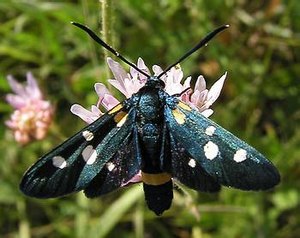Mutable red ram
| Mutable red ram | ||||||||||||
|---|---|---|---|---|---|---|---|---|---|---|---|---|

Variable ram ( Zygaena ephialtes ), ephialtoide form |
||||||||||||
| Systematics | ||||||||||||
|
||||||||||||
| Scientific name | ||||||||||||
| Zygaena ephialtes | ||||||||||||
| ( Linnaeus , 1767) |
The mutable red ram or ringed crown vetch ( Zygaena ephialtes ) is a butterfly ( moth ) from the ram family (Zygaenidae).
features
The moths reach a wingspan of 30 to 40 millimeters. As their German name suggests, they are mutable , as the color of the five to six spots on their forewings can vary widely. The spots can be colored from red to yellow to white. The most important identification and differentiation feature is the red, sometimes also yellow segment ring (belt) on the back of the abdomen . The hind wings are colored red, yellowish or completely black and have a fine, black outer edge. Sometimes you can find one or two other bright spots on them. The tips of the antennae are white.
The caterpillars are about 22 millimeters long. They have a greenish-yellow basic color and have a side line made up of small black dots and a further line made up of larger, sometimes square spots on both sides of the back. A fine, mostly interrupted back line runs on this.
Polymorphism
The changeable red ram is a polymorphic species. The moths can be assigned to different morphs. There are ephialtoid forms, these are similar in color to the genus Amata of the bear moth (Arctiidae); see e.g. B. Amata phegea . They are characterized by white spots on the upper side of the wing and have a yellow segment ring. In contrast, the peucedanoid moths are similar to the six-spot rams ( Zygaena filipendulae ). They have five to six red spots on the upper side of the wing and have a red body ring. These characteristics are genetically fixed and are freely combined in the inheritance. These allele combinations occur in different proportions in the individual populations and subspecies . The dominant alleles are peucedanoid and dominate over the ephialtoids. The changeable ram was used by scientists because of its pronounced polymorphism to examine the Mendelian laws in insects.
Subspecies
The individual morphs were initially regarded as separate species by the first descriptors in the 18th and 19th centuries (e.g. Sphinx peucedani, Sphinx athamanthae, Spinx coronillae). They were later widely used as aberration names, but these are no longer in use today. Today there are two subspecies of the variable red ram:
- Z. ephialtes ephialtes
- Z. ephialtes coronillae
Similar species
- White-spot ram ( Amata phegea ) (Linnaeus, 1758)
- Amata ragazzii (Turati, 1917)
- Similar white-spot ram ( Amata kruegeri ) (Ragusa, 1904)
Occurrence
The variable ram occurs in various forms in large parts of Europe , on the Iberian Peninsula only in the Pyrenees , east of the Black Forest , in the Alps and in the Alpine foothills , on the British Isles and in Scandinavia . It is very rare, but they are more common in the Jura des Franken and also in southern Europe . The moths are found preferentially where the food plants of the caterpillars occur in larger stands, such as on embankments and road embankments, but in any case only on limestone soils , poor grassland and in sparse forests. Warmer, dry areas and sunny slopes are also preferred, so the population decreases towards the north.
Way of life
Flight and caterpillar times
The moths fly in one generation from early July to August. The caterpillars can be found from September and after wintering until June of the following year.
Food of the caterpillars
The caterpillars primarily feed on red vetch ( Securigera varia ), but also on wild thyme ( Thymus serpyllum ), horseshoe clover ( Hippocrepis comosa ) and other types of clover ( Trifolium ), speedwell ( Veronica ) and plantain ( Plantago ).
development
The females lay their eggs on the caterpillars' forage plants. The caterpillar usually overwinters several times until it finally pupates in an elongated, silver-white web on stems or shrubs.
Hazard and protection
- Red list FRG: 3 (endangered).
Individual evidence
- ↑ Günter Ebert (Ed.): The butterflies of Baden-Württemberg , Volume 3: Moths I (root borer (Hepialidae), wood borer (Cossidae), ram (Zygaenidae), snail spinner (Limacodidae), bag bearer (Psychidae), window spot (Thyrididae)) . Ulmer Verlag, Stuttgart 1993, ISBN 3-800-13472-1
- ↑ Federal Agency for Nature Conservation (Ed.): Red List of Endangered Animals in Germany. Landwirtschaftsverlag, Münster 1998, ISBN 978-3-896-24110-8
literature
- Heiko Bellmann : The new Kosmos butterfly guide. Butterflies, caterpillars and forage plants. Franckh-Kosmos, Stuttgart 2003, ISBN 3-440-09330-1 .
- Günter Ebert (Eds.), Thomas Esche, Rene Herrmann et al .: The Butterflies of Baden-Württemberg , Volume 3: Moths I (root borer (Hepialidae), wood borer (Cossidae), ram (Zygaenidae), snail moth (Limacodidae), bag bearer ( Psychidae), window stains (Thyrididae)) . Ulmer Verlag, Stuttgart 1993, ISBN 3-800-13472-1
- J. Settele, R. Feldmann & R. Reinhardt: The butterflies of Germany. Ulmer, Stuttgart 1999/2000, ISBN 3-800-13519-1
- CM Naumann, GM Tarmann, WG Tremewan: The Western Palaearctic Zygaenidae. Apollo Books, Stenstrup, 1999, ISBN 87-88757-15-3
Web links
- Lepiforum e. V. Taxonomy and Photos
- www.schmetterling-raupe.de
- Moths and Butterflies of Europe and North Africa (English)
- Markku Savela: Lepidoptera and some other life forms (English)
- Zygaena ephialtes at Fauna Europaea

